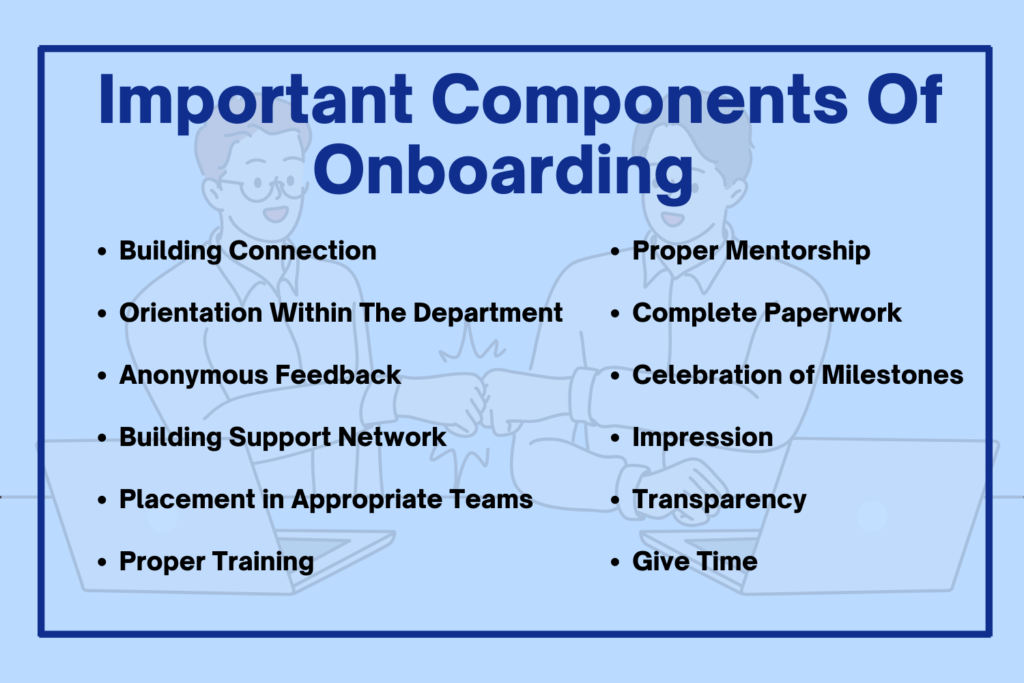“Onboarding“… what does this term even mean?
Onboarding is the process by which new hires are integrated into the organization. It includes activities that allow new employees to complete an initial new-hire orientation process, as well as learn about the organization and its structure, culture, vision, mission, and values.
With the new office, new work culture, new people, and new environment; new hires have to go through a lot and it is necessary to make them comfortable and confident. An effective Onboarding process can make everything fall in place for the employees. They need to feel at home and not on some alien planet.
A survey has shown that 30℅ of the newly hired employees leave the company within 6 months and half of them leave within 2 months of Onboarding.
This means they are not comfortable in the office environment and their colleagues there. Proper Onboarding is required to check this thing from happening.
Table of Contents
Essential Components Of Onboarding Are Mentioned Below
1. Building Connection:-
The main focus should be on building connections with everything with the people in the organization, the company, the work, and everything else. They should feel comfortable around other employees to be their most efficient selves.
And to make them comfortable help them build connections through official orientation programs, entertainment programs, virtual fun conferences, etc.
2. Orientation Within The Department:-
The employees are closer to or work closely with their respective teams in a given department hence there should be regular interaction between the team members within a department. To ensure this, arrange an orientation program within departments.
3. Anonymous Feedback:-
Place a feedback box in a corner where there is no camera surveillance to help people drop anonymous feedback. This ensures privacy along with their urge to suitable things up for themselves. This helps you understand the internal problems of your company as well as solve them.
4. Building Support Network:-
As work-from-home is being adopted by most companies it is very common for new employees to feel lost. They might wonder whom to talk to and from whom to seek help when stuck in a bad situation.
Therefore introduce them to their support networks and tell them about their roles and responsibilities so that they will not feel lost when stuck. Not only introduce them but help them mingle to avoid any conflict in the future.
5. Placement In Appropriate Teams:-
Every new employee needs to have a comfortable team. And ensure this action you need to study every new hire minutely. If someone is a fresher you need to pair him up with an experienced one and so on.
6. Proper Training:-
You can not just train all the new hires in one place. You need to place them in adequate teams and follow up with your training program. All the freshers should be placed in one group as they need more attention and needs the most help.
Then the entry-level employees should be placed in one group so that they can get the required attention and training and so on.

7. Proper Mentorship:-
The fresh hires need a constant and proper mentor to cope with your company’s policy and strategies. To run everything smoothly you need to pick out experienced employees who can play the role of good mentors and help the new employees from the very first day.
8. Complete Paperwork:-
Complete all the paperwork on the first day itself. This shows your professionalism as an established company and clears all doubts in the employee’s mind.
9. Celebration Of Milestones:-
On the day of new employees’ orientation arrange a program to felicitate and celebrate milestones of your existing employees. This encourages the new hires to work better and accomplish these milestones one day.
10. Impression:-
The first impression is very impactful on everyone’s life therefore make sure to impress the new candidates. Make sure they feel you are the best and they have achieved a great milestone in their career just by joining your company.
They in no way should be disappointed or regret joining your company. This will affect their work adversely and they will look for ways to leave your position.
11. Transparency:-
Your every move and future strategies should be clear to the employee there must not be any kind of glitch in this. They should have a clear idea of what they are getting themselves into. Do not commit to anything you can not fulfill later.
This will make the employee think of you as a fraud. Similarly, talk to them about your expectations from them in the short term as well as in the long term. There should be complete transparency between them and the company’s vision.
12. Give Time:-
No one knows everything since birth. Give adequate time for the new hires to fall in place, understand, and follow up without making any mistakes.
Be patient with them and help them learn. You never know who can prove to be an asset therefore help everyone and let them take their time to learn things and master them.

Changes are the only constants yet they are the most difficult part. In a business adjusting to new employees is difficult for the existing employee, the new employee as well as the employer.
The Onboarding procedure is tough and complicated because it decides the working tenure of your freshly employed employees. Research has confirmed that 69% of employees stay with the company if they are well-convinced and welcomed during Onboarding.
Most companies neglect this step of Onboarding and take it lightly but remember this is the base for extracting the best from your new employees. You make them feel comfortable and at home through simple efforts and they will bring back new ideas and growth to your company.
Arrange a smooth Onboarding and orientation starting with the history of the company and its achievements this will motivate the employees and will help them realize how much this company means to you which will help them connect on emotional levels with you and the company.


 Like
Like LOVE
LOVE Win
Win Cute
Cute LOL
LOL OMG
OMG WTF
WTF Fail
Fail


